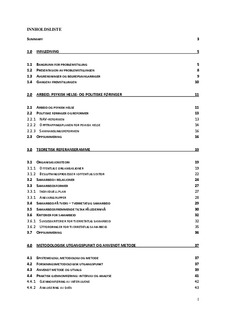Hvilke faktorer medvirker til å fremme og hemme tverretatlig samarbeid mellom NAV og kommunehelsetjenesten: Om NAV-ansattes erfaringer og refleksjoner i forhold til samarbeid med kommunehelsetjenesten
Master thesis
Permanent lenke
http://hdl.handle.net/11250/267876Utgivelsesdato
2012Metadata
Vis full innførselSamlinger
- Institutt for sosialt arbeid [1291]
Sammendrag
There has been a national focus in Norway on services provided for individuals with mental disorders, especially with regard to the municipal services,since the end of the 1990s. Collaboration between different sections in the municipalitieshas received increased attention. This study focuses on inter-agency collaboration between two of these agencies, the Norwegian labor welfare system (NAV) and the municipality health services, based on the NAV employees' experience of collaboration. The following research question was developed: What factors contribute to promoteand inhibitcooperation between NAV and municipality health services? In addition, the following sub-question has been formulated: What are the experiences and reflections of NAV employees in relation to the collaboration with the municipality health services? This was a qualitative study where five informants from two municipalities in Norway were interviewed. The main research method utilized was qualitative interviews. The analysis was conducted with a basis in the research methodological perspective phenomenologyand the interpretating modelofhermeneutics. The analysis methods utilized were the theme-centered approach as well as the method of meaning condensation. The analysis was based on the knowledge and theory collection of Norwegian public documents that focused on mental health, work and interdisciplinary collaboration, as well as theoretical perspectives from organizational theory and systems thinking. In addition, theory and research on inter-agency cooperation are presented.
The findings of the study show that cooperation is affected by the presence of a few key factors. It can best be explained if we envision each factor on a scale where thecollaboration is stimulated if thepresence of the factor increases.These factors were:Knowledge among the employees about each other's fields, including legislation, measures, methods and practical solutions; a defined division of roles and responsibilities between participants in the collaboration; the experience of usefulness for the employees themselves and on behalf of the users/clients; communication tools which facilitate information flow; and at last that the employee has cooperative skills particularly directed at interdisciplinary collaboration. In addition, the study found three overarching factors affecting the interdisciplinary cooperation: Allocation of sufficient resourcesenabling the units to prioritize interdisciplinary collaborationand a management team that takes responsibility for facilitating inter-agency cooperation;well-developed municipal employment/activity measures for people with mental disorders/problems; and at lastthe empowerment of the client.
